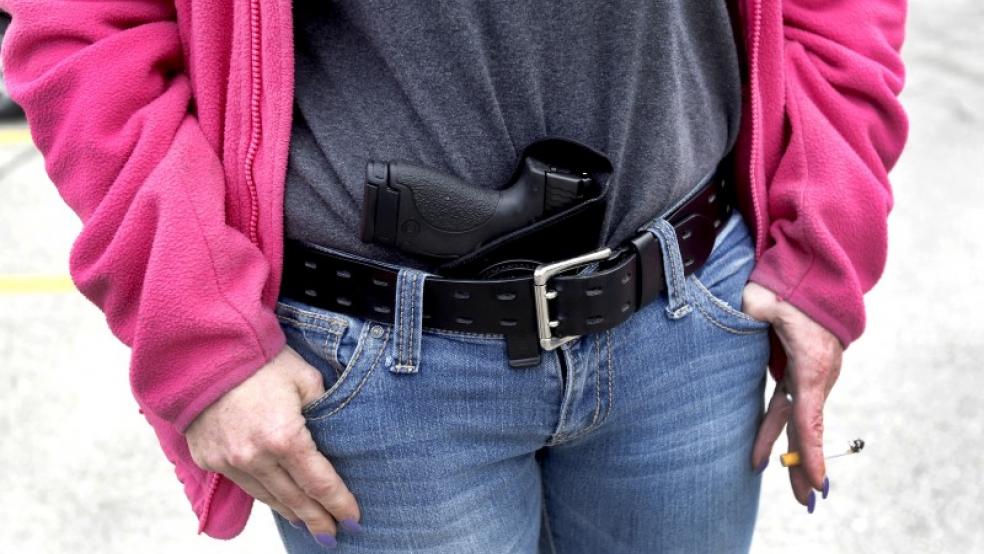In the aftermath of the shooting of a Congressman and four other individuals in Northern Virginia last week, during a practice session for a charity baseball game, the debate over whether easier access to guns makes a community safer or puts it more in jeopardy was renewed again.
Georgia Rep. Barry Loudermilk, who was at the field when now-deceased James T. Hodgkinson opened up on players with a rifle, told reporters that an aide of his was in the parking lot behind the shooter when the attack took place.
Related: 10 Weapons You Won't Believe Are Legal
“I had a staff member who was in his car maybe 20 yards behind the shooter, who was pinned in his car, who back in Georgia carries a 9-millimeter in his car,” he told The Washington Post. “He had a clear shot at him. But here, we’re not allowed to carry any weapons here.”
New York Republican Rep. Chris Collins told a hometown television station that he sometimes carries a weapon in the glove compartment of his car. “But it's going to be in my pocket from this day forward.”
(Loudermilk wasn’t precisely correct. In Virginia, where the shooting occurred, it is not illegal per se to carry a concealed weapon.)
It’s not at all uncommon, in the wake of mass shootings, to hear the claim that if only there had been someone else there carrying a weapon -- the National Rifle Association’s “good guy with a gun” -- the perpetrator could have been killed or incapacitated before he could do more harm.
One can argue endlessly over whether or not the addition of more guns to a particular situation would have made it better or worse. Perhaps Loudermilk’s aide might have been able to end the attack before Hodgkinson did so much damage. Alternatively, maybe one of the two armed Capitol Police officers at the scene, already exchanging fire with the shooter, might have seen the appearance of another unidentified armed man as a new threat, and shot Loudermilk’s aide as well as the gunman.
Related: Here’s Why Gun Control Isn’t Going Anywhere in Congress
After Congresswoman Gabrielle Giffords and nine other people were shot at an event in Arizona in 2011, a bystander carrying his own weapon reported that in the confusion, he drew his gun and briefly considered shooting a man he saw holding a weapon, only to discover it was another bystander who had disarmed the original attacker.
But arguments over whether the addition of one more gun to a specific scenario would have changed the outcome tend to mask the broader question: What effect does the addition of more guns to society in general have on levels of violence?
A new study from the National Bureau of Economic Research tried to tackle that question by examining so-called “right-to-carry” states. Right-to-carry (RTC) laws typically require that law enforcement officials “shall issue” concealed carry permits to individual who request them, unless they have a legitimate reason to bar that person from carrying a weapon. That contrasts with jurisdictions where, if concealed carry is allowed at all, the issuance of a permit is contingent on an individual satisfying law enforcement officials that they have a legitimate need for one.
The study -- conducted by John J. Donohue and Abhay Aneja, both of Stanford Law School, and Kyle D. Weber, of Columbia University --- expands on earlier research into the question from 2004 by assembling more than a decade of additional data gathered over a period in which 11 more states adopted RTC laws.
Related: Gun Control — a New Look at the Second Amendment
The findings, according to the authors, were unambiguous when it comes to the impact RTC laws have on violent crime. Passing such laws is closely associated with higher rates of violence -- a 13-to-15 percent higher rate over 10 years -- and the level of violence increases the longer the laws are on the books.
It is important to note that the measurement of crime across the 50 states took place at a time when crime rates were falling across the board. The study does not, for the most part, find that crime rates actually went up in states where RTC laws were passed. Instead it finds that the rate of decrease in violent crime in those states lagged behind what the statistical models predicted if RTC laws had not been passed.
According to the data, the passage of RTC laws has a large and statistically significant effect on the level of violent crime across individual states. But while statisticians might be quick to accept the findings, it will be more difficult for the average reader. A smaller decrease in violent crime is harder to articulate as an effect than a simple increase.
The report also has a counterintuitive finding -- despite the higher rate of violent crime detected in RTC states, there was no statistically significant impact on murder rates. The authors offer an explanation of that finding that hinges on increased policing and incarceration rates in RTC states, but those variables fall outside the model whose results are cited.
Nevertheless, the authors offer a conclusion that for an academic paper is unusually definitive.
“There is not even the slightest hint in the data that RTC laws reduce violent crime,” they write. “Indeed, the weight of the evidence from the panel data estimates as well as the synthetic controls analysis best supports the view that the adoption of RTC laws substantially raises overall violent crime in the ten years after adoption.”





